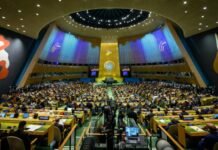United Nations (UN) issued a report on the issue of human trafficking that shows that there occurred dramatic shifts in trafficking due to the COVID-19 pandemic.
Findings of Report on Human Trafficking
Number of Detected Victims Falls
For the first time in 20 years, the number of detected victims fell as the pandemic restricted opportunities and also contained the activity of law enforcement agencies.
There occurred an 11 percent reduction in the number of victims detected as compared to 2019. This happened largely in low- and middle-income countries.
The data reduction is given below. In 2020, the number of victims decreased for the first time globally.
| Regions | Reduction in Percentage |
| East Asia and the Pacific | 59% |
| North Africa and the Middle East | 40% |
| Central America and the Caribbean | 36% |
| South America | 32% |
| Sub-Saharan Africa | 12% |
Trends in the number of detected victims region-wise (2020)
The downward trend during the pandemic was because of the lower institutional capacity to detect victims fewer opportunities for traffickers to operate due to Covid-19 preventive restrictions, and some trafficking forms moving to more hidden and less likely-to-be-detected locations.

Trafficking for Sexual Exploitation Less Detected
There is a 24 percent reduction in the detection of victims trafficked for sexual exploitation as compared to 2019. Most of the identified sexual exploitation happened in public spaces, such as bars, clubs, and outdoors.
Sexual exploitation was reduced due to the protective measures applied during the COVID-19 pandemic.
This happened mainly due to the closure of public spaces and it may also push into less visible and less safe locations. In this scenario, it is harder to detect this kind of trafficking because it may be more concealed.
| Victims of Trafficking for Sexual Exploitation | Percentage |
| Outdoor Public Settings | |
| Street | 11% |
| Legal Brothel | 10% |
| Unofficial Brothel | 9% |
| Night Club | 10% |
| Bar | 14% |
| Massage Centre | 9% |
| Indoor Public Spaces | |
| Hotel | 11% |
| Apartment | 18% |
| Client’s Private Home | 5% |
| Cyber | 2% |
| Escort Agency | 0.5% |
Share of victims of the total reported in the court case summaries (2022)
Victims Rely On “Self-Rescue”
Most of the victims relied on self-rescue as they managed to escape and reached out to the authorities on their own initiative.
Law enforcement agencies, community groups, and civil society have taken the initiative in fewer cases. This constitutes an alarming result considering many victims of trafficking may not identify themselves as victims.

The above-mentioned data shows 41 percent of initial action by victims and 28 percent of initial action by law enforcement institutions (police, border guards, etc.).
While 11 percent of the initial action was taken by community/strangers, 10 percent of the initial action by the victim’s family, 9 percent of the initial action by other institutions or civil society 1 percent other actions.
Global Slowdown in Convictions Accelerated During the Covid-19 Pandemic
There occurred a 27 percent reduction in the number of convictions that were recorded in 2019. The number of convictions decreased since 2017.

There is a decrease of 18 percent in North Africa and the Middle East, a 21 percent decrease in Eastern Europe and Central Asia, and a 23 percent downward trend in East Asia and the Pacific.
Likewise, there is a decrease of 35 percent decrease in North America, a 45 percent decrease in Western and Southern Europe, a 54 decrease in Central America and the Caribbean, and a 56 percent decrease in South Asia.
On the other hand, increasing trends are evident in some parts of the world such as a 22 percent increase occurring in Sub-Saharan Africa, and a 14 percent increase in Central and South-Eastern Europe.
Increased Impunity in Home Countries led to More Victims Trafficked to Other Destinations
The South Asian and Sub-Saharan countries convicted and detected few traffickers compared to the rest of the world.
Similarly, victims from these regions are identified in a wider range of destination countries compared to victims from other regions.
The data shows the number of destination countries detecting victims originating within and outside of the region from 2017-2020.
War and Conflict offer Hunting Grounds for Traffickers
Conflicts become the reason for the increase in the number of victims inside and outside the crisis area. The war in Ukraine and the refugee emergency is elevating risks of trafficking for the Ukrainian displaced population.
The 2014 conflict in Ukraine multiplied the number of Ukrainian victims detected in Western Europe in 2016. Similarly, bleak security situations in Africa and the Middle East give rise to human trafficking.

The chart above shows the detected victims of trafficking originating from a country in conflict, by region of citizenship in 2020.
Aside from that, 23.7 million people were internally displaced due to climate-induced disasters in 2021. This phenomenon forced people to move from one area to another and increased changes in human trafficking.

A New Form of Exploitations: Boys and Men Account for a Greater Share of Detected Victims
There is a new form of exploitation where boys and men have been detected in greater numbers over the past decade as victims of human trafficking.
Increasing proportions of identified victims are trafficked for forced criminality and mixed forms of exploitation. This form of human trafficking increased to 3 percent in 2019.
Similarly, the share of detected victims in criminal activities and mixed forms of trafficking has increased rapidly over the last five years.

Women and Children Suffer Greater Violence at the Hands of Traffickers
The court case analysis is evidence of the fact that female victims are subjected to physical or extreme violence at the hands of traffickers at a rate three times higher than males.
Whereas children are also subjected to either physical or extreme violence at a rate almost two times higher than adults. The below chart line shows the comparative trends of violence against men and women.

More organized traffickers exploit more human trafficking victims
The more organized type of trafficker is prone to the exploitation of more victims, the structure, strategy, and operationalization of an organization create greater impacts in exploiting victims.
The summaries of court cases reveal that organized criminal groups account for most detected victims and convicted offenders.
Individual traffickers operating on their own may traffic a few victims each, but globally they may account for a significant number of victims.
When larger, more structured criminal organizations get involved, they manage to traffic more people in a more violent manner and for longer periods.

Women are more likely than men to be traffickers or more likely to be convicted

Women who are investigated for trafficking in persons are more likely to be convicted than men. The above chart shows the difference between men and women, who were investigated, prosecuted, and convicted.
Region by region key developments in human trafficking
Central America and the Caribbean
There occurred a 60 percent decrease in male victims detected and a 67 percent decrease in female victims detected in the region.

Moreover, a large number of girls are trafficked for sexual exploitation and more than 10 percent of detected victims of sexual exploitation are males.
Central and Southeastern Europe
There is a continued increase in the detection of victims of trafficking in persons and the region recorded an increase in convictions in 2020 in the region.

Human Trafficking in East Asia and the Pacific
There witnessed a 59 percent decrease in the number of victims of trafficking detected in 2020 and an 81 percent decrease in the number of victims of cross-border trafficking in the region.
Besides, men and boys trafficked for sexual exploitation are more frequently reported than in other subregions. East Asian trafficking outflows remain of a global dimension as most regions detect victims from this part of the world.
Eastern Europe and Central Asia
There occurred a 41 percent increase in male victims detected, a 24 percent decrease in female victims detected, and a limited impact of the pandemic on the detection of trafficking victims in the region.
Similarly, a severe slowdown of the criminal justice response to trafficking was recorded in 2020.
Human Trafficking in North America
It is evident that a 26 percent increase in male victims was detected and a 14 percent increase in female victims detected in the region. Similarly, 35 percent drop in the number of convictions during 2020.
South America
Similarly, a 23 percent decrease in male victims was detected and a 38 percent decrease in female victims was detected in the region. The number of people convicted in the region was 46 percent lower than that seen in 2019.
South Asia
In South Asia, 31 percent decrease in detected victims trafficked for sexual exploitation, and in 2020, more men were detected as victims of trafficking compared to previous years.
Also, 23 percent decline in the number of domestic victims detected, and fewer victims per 100,000 population were detected than in other parts of the world in 2020.
Sub-Saharan Africa
The number of foreign victims detected in Sub-Saharan African countries fell, especially in comparison to 2018 levels but children continue to account for the majority of detected trafficking victims.
Similarly, between 2019 and 2020, the rate of child victims per 100,000 population increased by 43 percent.
Fewer victims per 100,000 population are detected than in other parts of the world as compared to other regions of origins of cross-border trafficking, Victims from Sub-Saharan Africa are detected in a growing number of countries, both within and outside the region of origin.
The Middle East and North Africa
In the Middle East and North Africa (MENA) 70 percent decrease in the number of victims of cross-border trafficking detected in 2020 compared to 2019.
Furthermore, 68 percent decrease in the detected child victims of trafficking in 2020 compared to 2019, and children were reported to be trafficked for exploitative begging.
Human Trafficking in Western and Southern Europe
In Western and Southern Europe, a 22 percent increase in male victims was detected in 2020 compared to 2019.
Also, a proportion of detected victims are trafficked to be exploited in criminal activity or mixed forms of trafficking and increased detection of domestic trafficking occurred.
Possible Responses to human trafficking
Develop and strengthen National Frameworks
The member states must develop and strengthen national frameworks for the identification and protection of victims, especially during a crisis.
Role of donor communities
Donor community and international organizations must enhance support for national authorities in identifying and protecting victims of trafficking, especially in low- and middle-income countries.
Promotion of joint interventions
Member countries must promote joint interventions bringing together law enforcement, social protection services, civil society organizations, and the private sector to identify and protect victims exploited in private apartments, hotels, and other concealed locations.
Promotion of government regulations
Member countries and the private sector must promote government regulation of online platforms, including robust obligations for online service providers to maintain the core responsibility to prevent and stop trafficking in persons.
Prevention measures against human trafficking
Member countries should implement preventive measures such as age and consent verification and high-visibility content removal request mechanisms online.
Diligence of operations and systems
Member countries must conduct regular due diligence of operations and systems based on concrete standards to identify risks of misuse of their platforms and resources by traffickers and to mitigate any risks.
Role of communities
Member countries must promote the role of communities to combat trafficking in persons i.e. if one sees something, say something approach.
Role of civil society to fight human trafficking
Member countries must promote social service providers and civil society as safe spaces for victim self-identification.
Promotion of judicial education
Member countries and international organizations must promote judicial education on trafficking in persons, including on technology-facilitated trafficking.
Trauma-informed investigations
Member countries should promote human rights-based and trauma-informed proactive investigations on cases of trafficking in persons.
Reduction of vulnerabilities
Member countries and international organizations must reduce vulnerability to trafficking within conflict areas by ensuring safe access to essential services and humanitarian support for affected populations.
Addressing gender biases
Member countries must systematically address gender biases in victim identification by ensuring that protection efforts also target men as potential victims.
Role of financial institutions
Financial institutions should establish financial information-sharing systems to monitor illicit transactions, particularly among remittance transfer services and banks.
Access to justice to curtail human trafficking
Member countries must ensure access to justice for women and girls investigated for trafficking in persons and related offenses.
Role of Academia
International organizations and academia must monitor the impact of climate change as a potential driver of trafficking in persons through targeted data collection and research.
Moreover, academia and international organizations must study patterns of sexual exploitation to inform more effective responses.
Iqra is a research scholar. She writes on various platforms. She is the author of two books. Her research interest includes politics, International relations, diplomacy, peace, and conflict studies, public administration, sociology and history.










